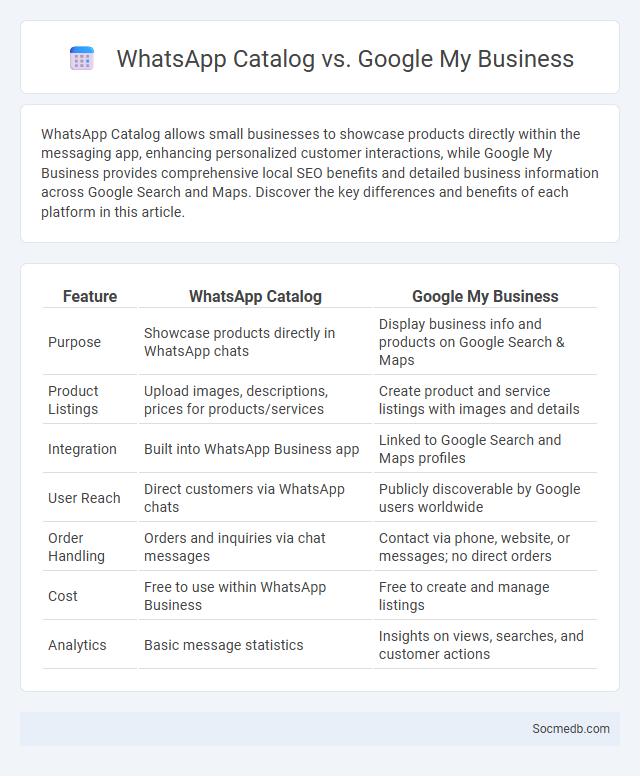
Photo illustration: WhatsApp Catalog vs Google My Business
WhatsApp Catalog allows small businesses to showcase products directly within the messaging app, enhancing personalized customer interactions, while Google My Business provides comprehensive local SEO benefits and detailed business information across Google Search and Maps. Discover the key differences and benefits of each platform in this article.
Table of Comparison
| Feature | WhatsApp Catalog | Google My Business |
|---|---|---|
| Purpose | Showcase products directly in WhatsApp chats | Display business info and products on Google Search & Maps |
| Product Listings | Upload images, descriptions, prices for products/services | Create product and service listings with images and details |
| Integration | Built into WhatsApp Business app | Linked to Google Search and Maps profiles |
| User Reach | Direct customers via WhatsApp chats | Publicly discoverable by Google users worldwide |
| Order Handling | Orders and inquiries via chat messages | Contact via phone, website, or messages; no direct orders |
| Cost | Free to use within WhatsApp Business | Free to create and manage listings |
| Analytics | Basic message statistics | Insights on views, searches, and customer actions |
Overview of WhatsApp Catalog, Google My Business, and Catalog Solutions
WhatsApp Catalog allows businesses to showcase products directly within the app, improving customer engagement through seamless interaction. Google My Business enhances local visibility by displaying your catalog, reviews, and contact information on Google Search and Maps, driving more traffic to your business. Combining Catalog Solutions from multiple platforms helps you optimize your sales funnel, ensuring your products reach the right audience efficiently.
Key Features Comparison
Social media platforms offer diverse key features such as Facebook's comprehensive user profiles, Instagram's visual storytelling tools, and Twitter's real-time microblogging capabilities. Engagement metrics including likes, shares, and comments vary in prominence across platforms, with TikTok emphasizing short-form video content and algorithm-driven feed personalization. Integration of business tools like Facebook Shops and Instagram Shopping enhances e-commerce potential, while LinkedIn specializes in professional networking and job search functionalities.
Ease of Setup and Integration
Social media platforms offer intuitive interfaces and robust API support that simplify setup and integration for businesses and developers. Pre-built plugins and third-party tools enable seamless connectivity with websites, e-commerce platforms, and customer relationship management (CRM) systems. Efficient integration improves content management and analytics tracking, enhancing overall marketing strategy effectiveness.
Product Display and Customization Options
Maximize your product display on social media by using high-quality images and detailed descriptions that highlight key features and benefits. Customization options such as color, size, and personalization choices should be clearly showcased through interactive posts or carousel ads to engage potential customers. Your ability to offer tailored product experiences drives higher conversion rates and builds stronger brand loyalty.
Customer Engagement and Communication Tools
Social media platforms offer diverse customer engagement and communication tools such as live chat, comment sections, and direct messaging that facilitate real-time interaction between brands and consumers. These tools enhance customer satisfaction and loyalty by providing immediate responses and personalized support. Advanced analytics integrated into social media channels enable businesses to tailor content strategies based on user behavior and preferences, optimizing engagement levels.
Payment and Order Management Capabilities
Social media platforms increasingly integrate advanced payment and order management capabilities to streamline e-commerce experiences, enabling users to make purchases directly within apps like Instagram and Facebook. These functionalities support seamless transaction processing, inventory tracking, and order fulfillment, reducing friction between browsing and buying. Businesses leverage data-driven insights from these platforms to optimize payment security and improve customer satisfaction in digital marketplaces.
Analytics and Performance Tracking
Social media analytics provides critical insights by measuring engagement rates, reach, and follower growth to optimize content strategies and maximize ROI. Performance tracking tools utilize metrics like click-through rates, conversion rates, and audience demographics to identify trends and refine marketing campaigns. Leveraging platforms such as Google Analytics, Facebook Insights, and Hootsuite enhances data-driven decision-making and boosts overall social media effectiveness.
Platform Accessibility and User Experience
Social media platform accessibility ensures inclusive design features like screen reader compatibility, keyboard navigation, and customizable text sizes, catering to users with diverse abilities. Optimized user experience on these platforms includes intuitive interfaces, fast load times, and personalized content algorithms that enhance engagement and satisfaction. Accessibility improvements and user-centric design directly impact social media retention rates and broaden audience reach.
Pricing and Cost Considerations
Social media platforms offer diverse pricing models, including freemium access, subscription plans, and pay-per-click advertising options. Businesses must evaluate cost considerations such as ad spend budgets, audience targeting efficiency, and expected return on investment to maximize campaign effectiveness. Understanding platform-specific pricing structures, like Facebook Ads' auction system or Instagram sponsored posts, is critical for optimizing marketing expenditures.
Choosing the Best Catalog Solution for Your Business
Selecting the best catalog solution for your business involves evaluating features like user interface, integration capabilities, and scalability to ensure seamless management of product listings across social media platforms. Prioritize solutions offering analytics and automation tools to optimize engagement and sales performance on channels such as Instagram, Facebook, and Pinterest. Your choice should enhance brand visibility while simplifying updates and inventory tracking to keep pace with market demands.
 socmedb.com
socmedb.com